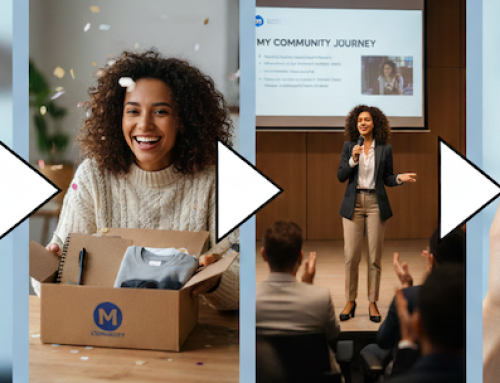As membership professionals handling member queries, services, events, and learning programmes, you’re truly at the coalface of understanding and delivering on membership experience.
Yet, while real-world expertise, engagement and demographic data provide a robust foundation, truly unpicking the needs and motivations of your diverse membership – and, critically, how your organisation can operationally meet them – requires a more human-centred approach. Crucial, given the long-term decline in membership numbers and fierce competition for people’s attention – and wallets.
What is Service Design and Why Can It Help?
Service Design is a human-centred design approach that’s impact is often explained as what makes you choose one coffee shop over another when they sell the exact same coffee at the same price!
Imagine one café offering a loyalty app, preordering, arriving to a warm greeting by name, versus another with long lines, stressed employees and, of course, you’ve forgotten your paper loyalty card again..!
The starkly different customer experiences flow from the entire organisation’s strategy, culture, processes, technology and business decisions taken in the past and present.
Service Design’s interdisciplinary approach combines business analysis with human insights to orchestrate and design the transformation needed to enhance overall membership experience, satisfaction and engagement. Making your lives as professionals far easier too.
But you don’t need to be a Service Design expert to start thinking like one.
Service Design Principles You Can Implement Now
- Actively Listen to Member Stories: Go beyond short-form surveys. Encourage members to share their honest experiences, challenges, and aspirations with open-ended questions. Document these stories and identify recurring themes to go beyond the ‘what’ to the ‘why’.
- Map Member Journeys: Even a simple visual representation of the key stages of membership – from onboarding to renewal and beyond – can reveal pain points and opportunities for improvement. Collaborate with colleagues from different departments to map these journeys from various perspectives and ‘fill in the gaps’.
- Develop Empathy Through Personas: Create simple representations of key member segments based on your understanding and member feedback. Focus on their needs, goals, frustrations, and interactions with your organisation to humanise your data and deliver genuinely relevant value. You can also use open-source tools like HMRC’s Empathy Hub to understand how diverse, disabled users might experience your digital products and services.
- Facilitate Informal Feedback Sessions: Formal research projects provide huge value but take time, when the world changes by the minute! A good way to take the organisation and its market landscape’s ‘temperature’ is to organise small group informal focus sessions with members to delve deeper into specific topics or challenges; uncovering insights traditional surveys might miss.
Taking Service Design Further: Collaborating for Member Experience
While professionals can implement Service Design practices, complex challenges especially involving technology often benefit from specialist expertise. Memberwise’s 2024 Digital Excellence report found fewer than 1 in 4 system integrations project met key success metrics, a similar failure rate to digital transformation projects in general.
Typically, this is due to a disconnect between strategy and stakeholder needs and the (in)ability to make the cultural and operational changes required by the transformation. This is where working with an objective, external partner can complement internal efforts to design transformation or support programmes underway.
As our coffee shop example shows, it’s not just the ‘front stage’ the member sees that matters, it’s everything that’s done ‘back-stage’ to deliver it, which Service Design’s systemic approach helps to solve:
- Collaborative Member Journey Mapping and Service Blueprinting: Facilitate workshops with diverse stakeholders to map complex member journeys and develop detailed service blueprints, identifying optimisation areas that might be otherwise missed internally.
- Strategic Alignment for Organisational Change: Align services with organisational strategy and support cultural and process changes, including team member upskilling.
- Advanced Qualitative and Quantitative Insights: Conduct in-depth interviews, surveys, and business analysis to uncover deep insights into member, stakeholder and operational needs and behaviours.
- Co-Creation and Innovation Workshops: Design and facilitate workshops to co-create new services, products, and experiences with members and stakeholders; engaging and aligning everyone in the process.
- Developing and Testing Prototypes: Create and test prototypes of new services and digital solutions with real members to ensure user-friendliness and effectiveness.
- Holistic, User-Centered Platform and Integration Strategy: Implement inclusive technology solutions aligned to the organisation’s unique needs. Whether it’s bespoke AMS, LMS, CMS, CRM or apps, or assurance of ‘off-the-shelf’ products, this helps deliver seamless integration, experience and eliminate data silos.
A Collaborative Approach to Member Value and Experience
As I started by saying, there’s no-one who understands members like membership professionals.
But keeping up with evolving technology, market trends and member demands, while managing business-as-usual is hugely challenging. Something that embracing a Service Design mindset and practical approach to empower your team can massively help with.
Then, when recognising it’s time to partner with specialists who can use their human-centred design and technology expertise to align diverse (sometimes difficult!) stakeholders and provide an objective 360° view, you can amplify and accelerate your transformation efforts. A collaborative approach that can drive meaningful, more engaging membership experiences and a sustainable future for your organisation.
If you’d like to explore how we can support your membership organisation with a practical Service Design approach—whether you’re just starting out or need help turning your concept into reality—get in touch with our team.











Leave A Comment